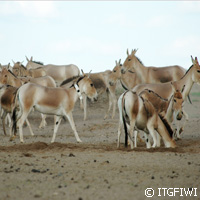Saving wild asses from extinction
Modern horses and donkeys are the descendents of the wild ass, which is now in danger of extinction. Pressure to save the wild ass intensifies as human activities like habitat destruction and hunting continue. Scientists led by the Research Institute of Wildlife Ecology at the University of Veterinary Medicine, Vienna in Austria have investigated the factors involved in the loss of the species. Presented in the journal Biological Conservation, the study tackles the question of how to protect this species' survival. While it populated many areas in the past, the wild ass currently makes its home in China, India, Iran, Mongolia and Turkmenistan; the Gobi Desert in Mongolia is a critical refuge area for this species. Professor Chris Walzer and colleagues at the Research Institute of Wildlife Ecology assessed the distribution of wild asses in the Gobi Desert and found the species in areas where the average production of biomass is below 250 grams of carbon per square metre per year. While the species were found in more productive regions in the past, human activity has played havoc on the animals' habitat and survival. They have either been chased away or killed by people to ensure that farmers' livestock have access to food and water, both of which are scarce in the Gobi Desert. Despite its hardiness, the wild ass still needs water and food to survive in the tough conditions of the desert and steppe, and the species has been forced to move into areas that cannot support it. For their study, the researchers fitted radio transmitters to almost 20 asses and monitored the animals' movements until the transmitters fell off (it should be noted that the transmitters were designed to do so). Their results confirmed that individual animals range widely yet steer clear from mountainous or hilly regions. They say the mountains that cut across the species' distribution in Mongolia impede the animals' movement. Genetic tests were used to corroborate information that the animals found on either side of the mountains are, in effect, isolated from each other. Thanks to efforts made by conservationists, however, the team found no evidence of a recent 'genetic bottleneck'. To sum up, the species showed a relatively high level of genetic diversity, both within and between the two subpopulations, according to the researchers. But they point out that the data obtained by the radio transmitters revealed that the wild asses either could not or were unwilling to cross man-made barriers including the Ulaanbaatar-Beijing railway line. Consequently, some 17 000 square kilometres of suitable habitat are unreachable for these animals. Also, a near 40-year-old border fence between Mongolia and China keeps the wild asses separated. The team says the Gobi Desert-based wild ass would benefit from a coordinated, multinational conservation plan. 'Opening the border fence, at least in places, would not only help the Asiatic wild ass but would also be likely to benefit other rare mammals, such as Bactrian camels and re-introduced Przewalski's horses.' Experts from the Technical University Munich in Germany, the Xinjiang Institute of Ecology and Geography in China, and the Mammalian Ecology Laboratory of the Institute of Biology at the Mongolian Academy of Science and the WWF Mongolia contributed to this study.For more information, please visit:University of Veterinary Medicine, Vienna:http://www.vu-wien.ac.at/en/Biological Conservation:http://www.elsevier.com/wps/find/journaldescription.cws_home/405853/description#description
Countries
Austria, China, Germany, Mongolia



